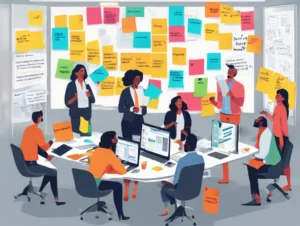What is reverse logistics? A simple way of explanation would be bringing back items from customer to producer. Or to put it into a picture

As always, let me try to illustrate it with a couple of real-life examples
- Glass bottles return scheme. People reading this who were adults in the last century remember bringing glass bottles to the store to replace with new full bottles. It was going mainly for water and beer, but I remember even milk bottles.
- Electronics trade-in scheme. This is something the young generations are aware of. Apple, for example, will take back your mobile phone in any condition. They claim they recycle them, but who knows? Anyway, reverse logistics takes care that they are brought to the service centre. Some countries have even legal requirements to recycle electronics at the end of their useful life. Like Japan for example.
- Goods returned by the consumer to the e-store is as well considered reverse logistics.
- If the product is faulty and needs to be brought back to the producer, either for repair or replacement with a new item.
- Expired food items. In many countries’ supermarkets cannot dump expired food in the garbage bins. They need to return it to the producer, who will destroy it. And they even get incentivized, as you can get the VAT refunded for unsold goods. I was never quite sure what is the real motive for this. To avoid smell spreading around cities? Food poisoning when the people living on the street start eating it? Had to organize this process during my work at a dairy factory. It was a dirty job getting all the expired milk back. Then we would have to count it and write a report. Only after approval and an occasional inspection we were allowed to destroy it. And in the summer, it was smelly…
- Is paper recycling a reverse logistics process? I would say no. Reverse logistics defines product return from the vendor to the customer. Here you have printing companies supplying to the user. Recycling companies collect it and send it to the paper mill. But in the printing industry, all paper waste is sent back to the paper mill. There we have a kind of reverse logistics.
As said, reverse logistics become more and more important. There is pressure to put in place the circular economy. Which in basics means that nothing should go to waste. It is also called the zero-waste economy or green economy. Besides the value that you could get from the returned product, it is as well a great branding tool.
How to organize reverse logistics in an effective manner? There are a couple of options available:
- Using the same transport that brought the goods to retail or consumer. It works if the volumes are large enough and the product can be transported in the same vehicle. When it comes to food, there are restrictions. Namely fresh and expired foods are not allowed in the same vehicle in many countries.
- If reverse logistics is significant it makes sense to organize a separate department.
- For some items, the producer will prepare a prepaid, pre-addressed envelope and place it in the packaging of the new product. So once the product you have been using reached its end-of-life, you place it in the envelope and send it back to the supplier. Some companies have provided discount coupons for those who take part.
Reverse logistics rarely adds value. Most often, it is a plain cost centre. While it is there for legal or branding reasons, the main goal of the Supply Chain Manager is to organize it cost-effectively. This is not your core business. See if it can be clapped into your existing logistics activities, or outsourced. The business needs it, and for us, it is an additional cost of people, time and vehicles. Get it done. Fast, efficient and cheap.

